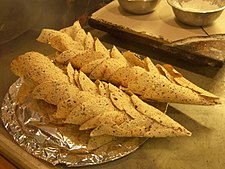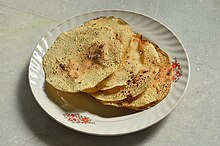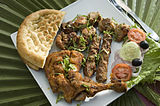Papadam
Apapadam(also spelledpoppadom,among other variants), also known aspapad,is a snack that originated in theIndian subcontinent.Dough ofblack gram beanflour is eitherdeep friedor cooked with dry heat (flipped over an open flame) until crunchy. Other flours made fromlentils,chickpeas,rice,tapioca,milletorpotatoare also used. Papadam is typically served as an accompaniment to a meal inIndia,Pakistan,Bangladesh,Nepal,Sri Lankaand theCaribbeanor as anappetizer,often with a dip such aschutneys,or toppings such as choppedonionsandchili peppers,or it may be used as an ingredient incurries.
Etymology
[edit]Papadamis aloanwordfromTamilபப்படம்pappaṭam,[1][2]and is likely derived fromSanskritपर्पटparpaṭa,meaning a flattened disc described in early Jain and Buddhist literature.[3][4]Papad is known by several names in the variouslanguages of India,e.g.पापड़pāpaṛinHindi;అప్పడంappaḍaṁinTelugu;அப்பளம்appaḷamorபப்படம்pappaṭaminTamil;ಹಪ್ಪಳhappaḷainKannada;පපඩම්papaḍaminSinhala;പപ്പടംpappaṭaminMalayalam;पापडpāpaḍinMarathi;[5]ਪਾਪੜpāpaṛinPunjabi;પાપડpāpaḍinGujarati;ପାମ୍ପଡpāmpaḍainOdia;andপাপড়pāpaḍinAssamese.[citation needed]
Regional variations
[edit]

Papad recipes vary from region to region and from household to household. They are typically made from a flour or paste derived from lentils, chickpeas, black gram, rice, or potatoes.[6]
Saltandpeanut oilare added to make a dough, which can be flavored with seasonings such aschili,cumin,garlic,orblack pepper.Sometimes,baking sodaorslaked limeare also added. The dough is shaped into thin, roundflatbreads,dried (traditionally in the sun[7]), and can be cooked bydeep frying,roasting over an openflame,toasting, ormicrowaving,depending on the desired texture.
In mostIndian restaurantsaround the world, they are served as anappetizerwith dips, which often includemango chutney,lime pickle,onion chutney,andraita.[8]Masala papad withsev,onion, tomato and coriander leaves is one of India's most popular appetizers.
Ingredients and preparation
[edit]Papadam can be prepared from different ingredients and methods. One popular recipe uses flour ground from hulled split black gram[9]mixed with black pepper, salt, a small amount of vegetable oil and a food-grade alkali, and the mixture is kneaded. A well-kneaded dough is then flattened into very thin rounds and then dried and stored for later preparation and consumption. It may also contain rice,jackfruit,sago,etc., as main ingredients.
Cracked black pepper, red chili powder,asafoetida,cumin orsesameseeds are often used as flavoring agents. Papadam is also made from rice flakes, ragi orhorsegram.[10]
Gallery
[edit]-
Appadam
-
Ricepapadam
-
Uradal papadam
-
Fire-toasting papadam
-
A Nepalithaliwith papad
-
Raw jackfruit papad incoastal Karnataka
-
Papadams withchutneyare often served as an appetizer at South Asian restaurants around the world.
-
Microwaved papad texture
See also
[edit]- Indian bread– Wide variety of flatbreads and crêpes which are an integral part of Indian cuisine
- Sandige– Fried snack, originating from the Indian subcontinent
References
[edit]- ^"poppadom,n."OED Online.December 2006. Oxford University Press.<http://www.oed.com/view/Entry/147794?redirectedFrom=poppadum#>.
- ^"Digital Dictionaries of South Asia".1962.
- ^"Poppadom - Definition and synonyms of poppadom in the English dictionary".educalingo.com.Retrieved22 September2021.
- ^"Lip-Smacking Ways to Use Papad: From Masala Papad to Rolls and Chaats".NDTV Food.Retrieved12 September2022.
According to food historian and author KT Achaya, "The parpata (papad) is first mentioned in about 500BC in Buddhist-Jain canonical literature, and the medical authorities note that they are made from pulses like urad, masoor, chana and the like."
- ^Khedkar, Renu; Shastri, Pratima; Bawa, Amarinder Singh (2016)."Standardization, Characterization and Shelf Life Studies on Sandge, a Traditional Food Adjunct of Western India".International Journal of Environment, Agriculture and Biotechnology.1(2): 237–243.doi:10.22161/ijeab/1.2.18.
- ^Aoyagi, William Shurtleff; Akiko (17 February 2019).History of Soy Flour, Flakes and Grits (510 CE to 2019): Extensively Annotated Bibliography and Sourcebook.Soyinfo Center. p. 814.ISBN978-1-948436-06-9.
{{cite book}}:CS1 maint: multiple names: authors list (link) - ^B.Gangwar (21 January 2013).Solving The Pulses Crisis.New India Publishing Agency. p. 197.ISBN978-93-81450-48-2.
- ^"Poppadom Dips Recipe (easy Indian dips)".23 May 2023.
- ^J. Smartt; Emmanuel Nwokolo (6 December 2012).Food and Feed from Legumes and Oilseeds.Springer Science & Business Media. p. 28.ISBN978-1-4613-0433-3.
- ^"Poha papad, Rice flakes Papad, Summer Recipe".Udupi-Recipes. 11 March 2018.Retrieved9 January2020.
External links
[edit] Media related toPapadamsat Wikimedia Commons
Media related toPapadamsat Wikimedia Commons












